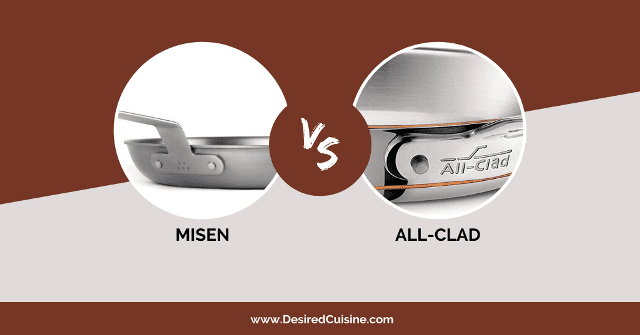Choosing between Misen and All-Clad can be a bit tricky if you are not familiar with their pros and cons. In this comparison, I will cover in detail the similarities and differences between these two brands, their costs and benefits, and which one is superior in terms of cooking performance, durability, collections, price, and design.
Quick Summary
Feature | Misen | All-Clad |
|---|---|---|
Construction | 3-Ply and 5-Ply | 3-Ply and 5-Ply |
Material | Stainless steel / Carbon steel / Nonstick / Cast iron | Stainless steel / Hard anodized-aluminum / Copper / Ceramic / Nonstick |
Oven-safe temperature | Up to 500 degrees | Up to 600 degrees |
Induction compatibility | Yes (except for nonstick pans, they don't perform great on induction burners) | Yes (except for hard-anodized collection) |
Metal utensil-safe | Only the stainless steel cookware | Yes |
Dishwasher-safe | Only the stainless steel cookware | Yes |
Handle type | Stainless steel with removable silicone | Stainless steel |
Lid type | Silicone | Stainless steel |
Number of collections | 3 | 9 |
Lifetime warranty | Yes (except for the nonstick cookware) | Yes (covers only defects) |
Price |
Introducing Misen
Founded by Omar Rada in 2015, Misen is a New York-based company that has several manufacturing partners in China where it fabricates most of its products.
This company is more of a versatile brand than All-Clad. It produces a variety of kitchen products such as cookware, kitchen tools, oven steels, dutch ovens, woks, santoku, and other types of kitchen knives.
Pros of Misen Cookware
- Diversity. When it comes to cookware, Misen uses various materials such as carbon steel, enameled cast iron, nonstick, and stainless steel in its constructions to create reliable pots and pans that can deliver high performance while excelling in specific areas.
- Inexpensive. Most of the cookware are under $200. This brand focuses on selling high-quality cookware within a reasonable budget directly to its customers.
- Great heat tolerance. The nonstick and carbon steel collections can endure temperatures up to 450 degrees Fahrenheit, while the stainless steel cookware can get up to 500 degrees.
- Safe nonstick surface. Misen combines its Plasma primer technology with a 3-layer Dupont platinum coating that’s PFOA-free to create a safe nonstick surface that can offer superior release.
Cons of Misen Cookware
- No warranty. Unfortunately, Misen has no lifetime warranty for its nonstick cookware. Most trusted brands offer at least a warranty that covers defects but in Misen’s case, there is none.
- Re-seasoning. For the carbon steel pans, seasoning is crucial since it creates and improves the natural nonstick coating. However, this layer can be easily removed if you use a dishwasher, abrasive tools, or even a dish soap when cleaning which would require you to re-season your cookware again.
- Quality of the nonstick coating. I’m not entirely satisfied with the overall quality of the coating. After a couple of months or even a year of daily use with proper care, the coating may start to chip. Undoubtedly, nonstick pans are replaceable however I would like to see a pan perform well for at least 5 years or so.
Introducing All-Clad
Founded by John Ulam, All-Clad is a U.S based company that excels in producing high-end cookware that meets or even exceeds the standards of the Cookware Manufacturers Association (CMA).
All-Clad is recognized for its cladding construction that creates outstanding stainless steel cookware that can easily handle the most demanding tasks in the kitchen.
Pros of All-Clad Cookware
- Different types of cookware material. All-Clad is known for its formidable stainless steel pans however, it started applying a variety of materials such as copper and nonstick in its cookware constructions to produce different types of pots and pans that can fulfill the needs of all cooks.
- Superb heat conductivity. This brand combines layers of metal with various cores to improve conductivity and heat retention. Depending on the cookware model, the core can either be pure aluminum like in D3, or a tri-ply core alternating stainless steel and aluminum as in D5, and it can even be a pure copper core as we have already mentioned in the All-Clad copper core review.
- Lifetime performance. All-Clad uses bonded sheets of 18/10 brushed Ni-Chrome Stainless Steel and aluminum or copper as the core to produce robust cookware that can conduct heat efficiently to secure the best performance possible.
- Lifetime warranty. All 3-ply and 5-ply products come with a lifetime warranty to prove how confident All-Clad is in its cookware. However, the warranty doesn’t cover wear and tear but only defects.
RELATED: All-Clad D3 vs D5 Cookware
Cons of All-Clad Cookware
- Difficult to clean. It can be quite annoying sometimes to clean up the fully clad cookware due to the pure stainless steel surface. Depending on what you often cook, you might end up using a cleaner with boiled water and a scraper to wash your pans, especially if there is much gunk around the cookware.
- Expensive. All-Clad pots and pans are 15% more expensive than most cookware available in the market. But, considering the long-term cost of purchasing over and over again new budget cookware, saving for All-Clad can be a wise decision.
- Lack of nonstick diversity. Unlike stainless steel lines, there are very few hard-anodized and nonstick collections to choose from which makes your options a bit limited. Not to forget, some of the nonstick cookware can only be bought locally. Read this HA1 vs B1 comparison for more information.
Misen vs All-Clad: Similarities and Differences

Misen and All-Clad share some common similarities however, their differences are what set them apart. Without further ado, here are the top five distinctions you need to know before choosing either brand.
Material and Construction
All-Clad is known for its skill to bond various metals together. It relies often on either 3-ply or 5-ply constructions to create superb cookware that is designed to provide incredible heat control, even distribution, and unmatched durability.
Misen on the other side, crafts different types of non-toxic cookware using several materials in its constructions specifically stainless steel, cast iron, carbon steel, and nonstick.
Similar to one of All-Clad’s methods, Misen produces its stainless steel cookware using a 5-ply construction where it combines thick layers of 18/10 stainless steel and aluminum. However, for the nonstick collections, this brand uses a 4.2mm thick, commercial-grade aluminum to create a flat nonstick base that can provide amazing even heat distribution.
RELATED: Best Cookware for Electric Coil Stoves
Cooking Surface
For the stainless steel category. All-Clad craft their pots and pans with a brushed polish stainless steel surface. Some of its collections have a three-layer of PFOA-free nonstick coating on the top to provide the smooth quality of nonstick. However, the interior is still made with pure stainless steel thus, food can stick to the surface over time.
Misen on the other hand creates a larger surface with nearly the same quality as All-Clad except that it has a poor treatment for its nonstick pans which can cause food to stick often if not treated well.
For the nonstick category. Misen combines a 3-layer Dupont platinum that can offer a superior release with its unique technology “Plasma Primer” which is basically a pretreatment done before applying the nonstick coating to ensure great durability and abrasion resistance of the coating.
As for the carbon steel pans, Misen relies on the patina (layers of fat) generated from seasonings to get the naturally nonstick coating. That being said, it will take you some time (around 2 months of daily and proper use) before you achieve a good smooth surface.
Design
All-Clad designs the majority of its cookware to be shallower with inclined edges. The shallow form makes the cookware a little bit easier to carry by anyone since it helps decrease some of the weight obtained from the bonding or cladding process. While the inclined edges facilitate sliding and pouring.
Misen is quite simplistic with its cookware design. Every pan and pot is crafted with a wide interior and curved edges to make it easier for you to cook more food and toss them around.
When it comes to the weight, unlike the carbon steel pans which are considered to be super light, the stainless steel collections are a bit heavier due to the 5-ply constructions which make handling the cookware a bit uncomfortable for some people, but not to an extent that you can't carry it with one hand.
Both brands add a magnetic base to their stainless steel cookware to secure great compatibility and versatility to work on any heat source including induction cooktops without losing any of their qualities.
RELATED: Best Cookware for Induction Cooktops
Handle
Both Misen and All-Clad craft stainless steel handles that are secured with high-quality steel rivets to the base to slow down the heat for a comfortable, safe grip.
The only difference between the two is the way they try to disperse the heat. Misen design most of its handles with two open areas at every end, while All-Clad prefers to craft a long U-shaped handle with just one open area at the end.
That being said, All-Clad’s handles remain cool to the touch despite the cookware temperature, while Misen’s handles can get a bit warmer after long cooking.
Price
All-Clad creates high-end collections that can offer outstanding performance to satisfy expert chefs as well as home cooks. Hence, it carries a heftier price tag than Misen.
Misen is leaning more towards crafting a variety of inexpensive cookware that can deliver the performance a home cook needs to cover his daily cooking without breaking a budget.
For a better understanding of the cost, here are some examples of All-Clad and Misen cookware prices:
- Misen 3-Piece Starter Cookware Set: $225
- Misen 5-Piece Essentials Cookware Set: $375
- Misen 7-Piece Complete Cookware Set: $475
- All-Clad Essentials 10-Piece Cookware Set: $400
- All-Clad HA1 Hard-Anodized Aluminum 13-Piece Cookware Set: $600
- All-Clad D3 Stainless Steel 10-Piece Cookware Set: $700 ($800 for the nonstick version)
- All-Clad D5 Brushed Stainless Steel 10-Piece Cookware Set: $800
- All-Clad Copper Core 10-Piece Cookware Set: $1450+
All-Clad vs Misen: Cookware Comparison
Cookware Brand | Cookware Set | Cooking Surface | Core Type | Induction Compatibility | Current Price |
|---|---|---|---|---|---|
Misen Stainless Steel Pan Set | Stainless steel | Aluminum | Yes | ||
Misen nonstick Pan Set | Platinum nonstick coating modified with Plasma primer | Aluminum | No | ||
All-Clad Ha1 Cookware Set | PTFE, PFOA-free | Hard anodized aluminum | Yes | ||
All-Clad D3 Cookware Set | Mirror polish only | Solid Aluminum | Yes | ||
All-Clad D5 Brushed Cookware Set | Brushed or polished | Bonded stainless steel and aluminum | Yes | ||
All-Clad Copper Core Cookware Set | Highly polished | Copper | Yes |
The Final Verdict
All-Clad produces cookware that can provide superb performance and last for a lifetime with proper care. However, they come at a high price. While Misen creates a variety of inexpensive cookware that can make your cooking more enjoyable and fun to do. However, they are replaceable since every piece is prone to lose its qualities over time.






